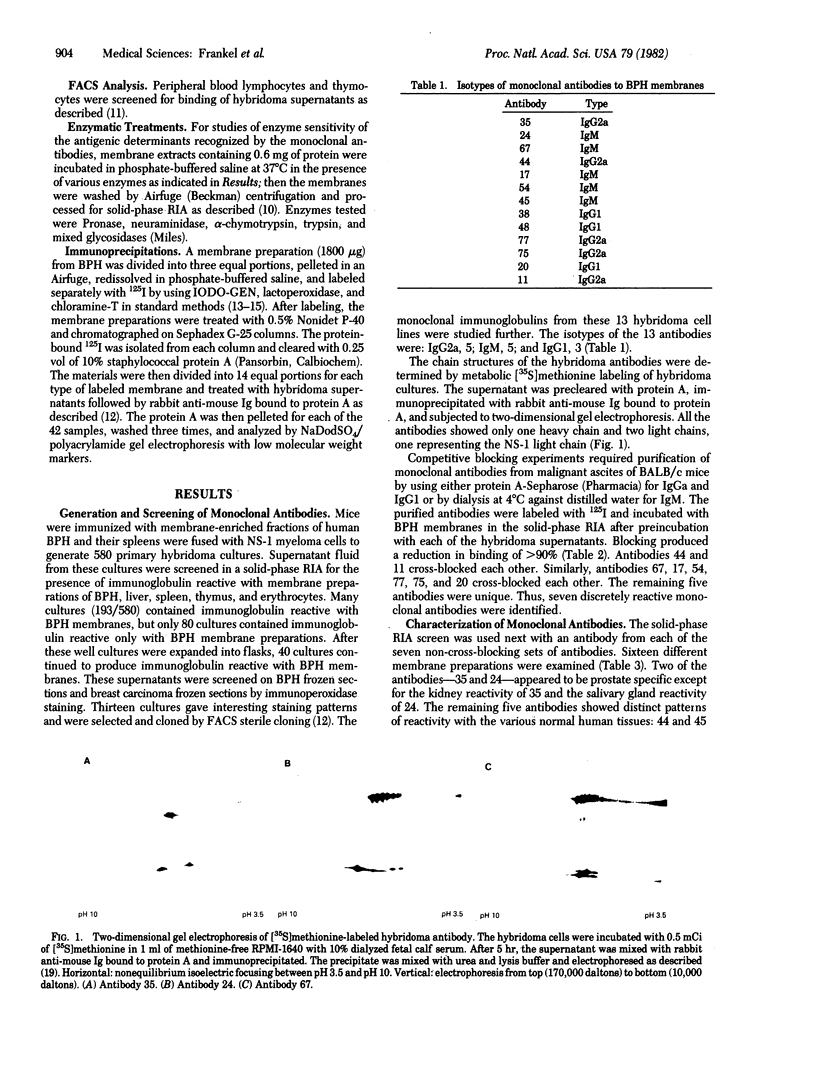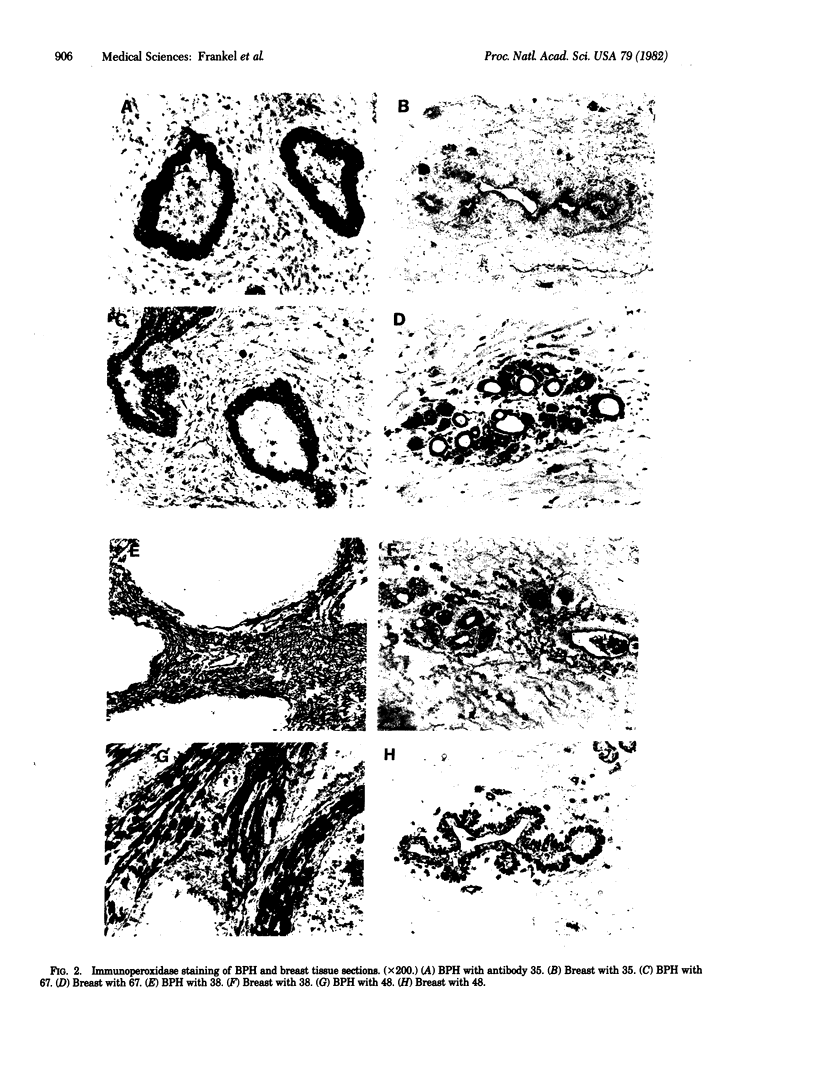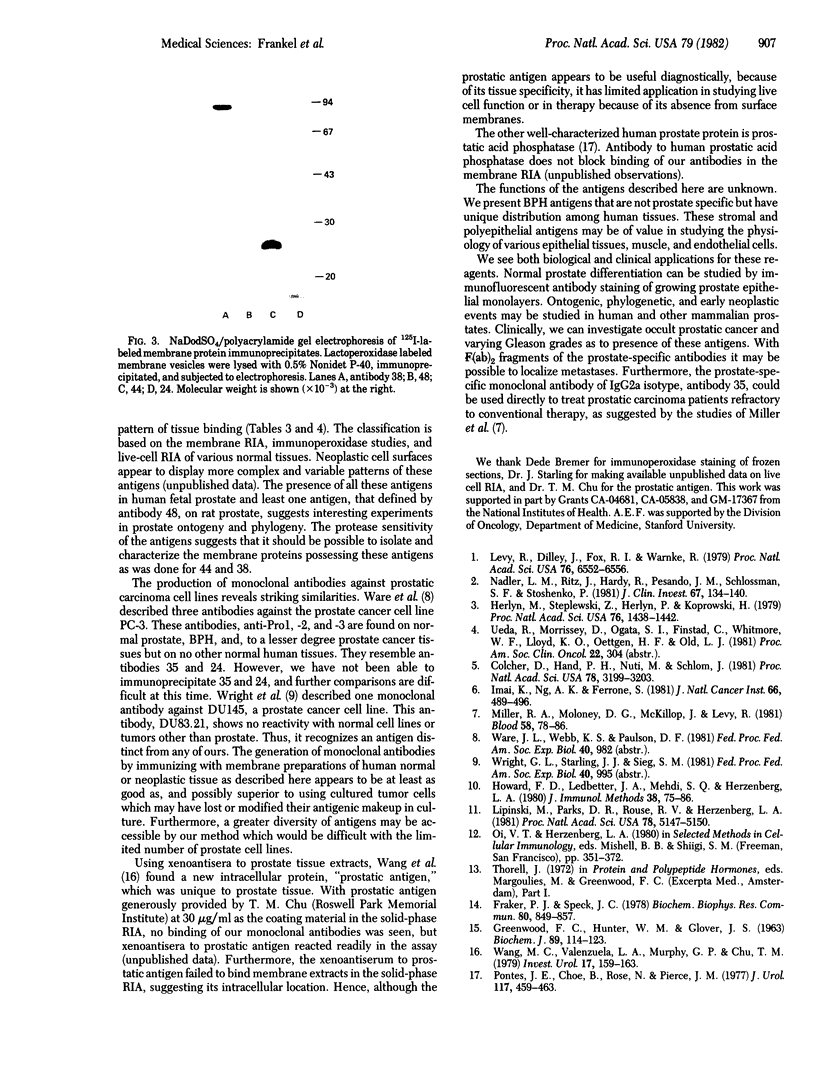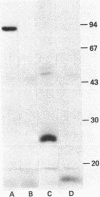Abstract
Splenic lymphocytes of BALB/c mice immunized with membrane-enriched fractions of human benign prostatic hyperplasia tissues were fused with the NS-1 light chain-secreting murine myeloma cell line. This generated hybridoma cultures that secreted immunoglobulins reactive in solid-phase radioimmunoassays with membrane preparations of prostatic tissues but not with membrane preparations of apparently normal human liver, spleen, thymus, or erythrocytes. After further screening of immunoglobulin reactivities and cloning of cultures, eight monoclonal antibodies were chosen that demonstrated reactivity with human prostate tissues. These monoclonal antibodies could be placed into at least three major groups--epithelium-specific, polyepithelial, and stroma-specific--on the basis of differential binding to the surfaces of various component cells in the prostate and other epithelia. Two antibodies defined unique protein antigens specific for prostate epithelia that were not crossreactive with prostatic acid phosphatase or the recently described "prostatic antigens." These antibodies also detected antigens on malignant prostate tissues as well as other malignant tissues. Four antibodies defined three unique polyepithelial protein antigens (two of the antibodies were different isotypes defining the same protein). Each of the polyepithelial antigens was expressed on a different spectrum of normal epithelial tissues. Two displayed brain tissue crossreactivity, one was present on pancreas, and one was present on platelets. The two antibodies that detected prostatic stromal protein antigens showed different spectra of reactivities. One antibody reacted with apparently all prostatic stromal cells as well as endothelial cells in the prostate and other organs. The other antibody apparently reacted with all prostatic stromal cells as well as myoepithelial and muscle cells in other organs.
Full text
PDF




Images in this article
Selected References
These references are in PubMed. This may not be the complete list of references from this article.
- Colcher D., Hand P. H., Nuti M., Schlom J. A spectrum of monoclonal antibodies reactive with human mammary tumor cells. Proc Natl Acad Sci U S A. 1981 May;78(5):3199–3203. doi: 10.1073/pnas.78.5.3199. [DOI] [PMC free article] [PubMed] [Google Scholar]
- Fraker P. J., Speck J. C., Jr Protein and cell membrane iodinations with a sparingly soluble chloroamide, 1,3,4,6-tetrachloro-3a,6a-diphrenylglycoluril. Biochem Biophys Res Commun. 1978 Feb 28;80(4):849–857. doi: 10.1016/0006-291x(78)91322-0. [DOI] [PubMed] [Google Scholar]
- GREENWOOD F. C., HUNTER W. M., GLOVER J. S. THE PREPARATION OF I-131-LABELLED HUMAN GROWTH HORMONE OF HIGH SPECIFIC RADIOACTIVITY. Biochem J. 1963 Oct;89:114–123. doi: 10.1042/bj0890114. [DOI] [PMC free article] [PubMed] [Google Scholar]
- Herlyn M., Steplewski Z., Herlyn D., Koprowski H. Colorectal carcinoma-specific antigen: detection by means of monoclonal antibodies. Proc Natl Acad Sci U S A. 1979 Mar;76(3):1438–1442. doi: 10.1073/pnas.76.3.1438. [DOI] [PMC free article] [PubMed] [Google Scholar]
- Howard F. D., Ledbetter J. A., Mehdi S. Q., Herzenberg L. A. A rapid method for the detection of antibodies to cell surface antigens: a solid phase radioimmunoassay using cell membranes. J Immunol Methods. 1980;38(1-2):75–84. doi: 10.1016/0022-1759(80)90332-4. [DOI] [PubMed] [Google Scholar]
- Imai K., Ng A. K., Ferrone S. Characterization of monoclonal antibodies to human melanoma-associated antigens. J Natl Cancer Inst. 1981 Mar;66(3):489–496. [PubMed] [Google Scholar]
- Levy R., Dilley J., Fox R. I., Warnke R. A human thymus-leukemia antigen defined by hybridoma monoclonal antibodies. Proc Natl Acad Sci U S A. 1979 Dec;76(12):6552–6556. doi: 10.1073/pnas.76.12.6552. [DOI] [PMC free article] [PubMed] [Google Scholar]
- Lipinski M., Parks D. R., Rouse R. V., Herzenberg L. A. Human trophoblast cell-surface antigens defined by monoclonal antibodies. Proc Natl Acad Sci U S A. 1981 Aug;78(8):5147–5150. doi: 10.1073/pnas.78.8.5147. [DOI] [PMC free article] [PubMed] [Google Scholar]
- Miller R. A., Maloney D. G., McKillop J., Levy R. In vivo effects of murine hybridoma monoclonal antibody in a patient with T-cell leukemia. Blood. 1981 Jul;58(1):78–86. [PubMed] [Google Scholar]
- Nadler L. M., Ritz J., Hardy R., Pesando J. M., Schlossman S. F., Stashenko P. A unique cell surface antigen identifying lymphoid malignancies of B cell origin. J Clin Invest. 1981 Jan;67(1):134–140. doi: 10.1172/JCI110005. [DOI] [PMC free article] [PubMed] [Google Scholar]
- Pontes J. E., Choe B., Rose N., Pierce J. M., Jr Indirect immunofluorescence for identification of prostatic epithelial cells. J Urol. 1977 Apr;117(4):459–463. doi: 10.1016/s0022-5347(17)58498-0. [DOI] [PubMed] [Google Scholar]
- Wang M. C., Valenzuela L. A., Murphy G. P., Chu T. M. Purification of a human prostate specific antigen. Invest Urol. 1979 Sep;17(2):159–163. [PubMed] [Google Scholar]














